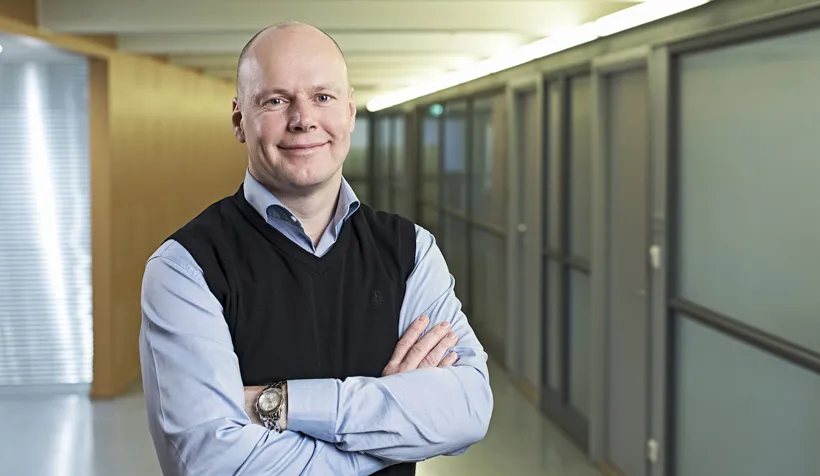Energy brings companies together in Vaasa -Financing solutions are often important in export trade

Over the years, the Ostrobothnia region has become home to an exceptionally active hub of companies that promote one another’s growth. All the companies in the cluster work with energy in one way or another. Wärtsilä is one of the companies driving exports in the area. One of the growth companies WE Tech wants to cut the energy consumption of ships by one-third, says CEO Mårten Storbacka.
The energy cluster in Ostrobothnia boasts impressive figures. It comprises approximately 150 companies with a combined revenue of over four billion euros. The companies employ a total of 11,000 people, of which over 1,000 work in product development.
One of the most successful growth companies in the area is WE Tech, which specialises in improving energy efficiency in the marine sector. The company’s vision is to reduce oil consumption in the global shipping industry by one-third.
CEO Mårten Storbacka sees the extensive network of experts as Vaasa’s strength. WE Tech’s key employees used to work at other companies in the cluster before joining the company.
“We benefit one another. We have a strong culture of win-win strategies,” Storbacka says.
WE Tech uses permanent magnet and variable speed drive technology. To put it more simply, a shaft generator is installed in the ship and it provides energy while the vessel is at sea. The auxiliary engines can be shut down, which reduces fuel consumption.
WE Tech’s partners include the wind power company The Switch and Danfoss Drives (former Vacon).
“We are the leading company in our sector. Our services cover the entire life cycle of the solution, from sales to maintenance,” Storbacka says.
The company’s leading position and the prospect of partnering with larger enterprises also interests suppliers. CEO Storbacka says that smaller companies are interested in collaboration with WE Tech and, on the other hand, WE Tech is constantly on the lookout for new partners.
Last year, WE Tech’s revenue amounted to EUR 6.2 million, and this year’s forecast is EUR 12 million. The company has immense potential to grow because hundreds of new cargo vessels are ordered every year.
“Our competitors are large, global enterprises, but our technical expertise is unrivalled. We have also collected an impressive list of references of past deliveries. Potential new customers want to know what we have achieved so far. We also rely on our service network of partners that covers over 50 countries,” Storbacka says.
Leading export companies teach others
Up to one-third of exports in the Finnish energy sector originate from the Vaasa region.
According to John Erickson, Regional Manager for Western Finland at Finnvera, the importance of major companies like Wärtsilä can be seen in the statistics.
“These important export companies have also attracted other growth companies to the area, such as engineering offices, component manufacturers and software developers,” Erickson lists.
Leading export companies like Wärtsilä also cooperate with one another. Wärtsilä’s Energy Solutions unit in Vaasa exports, among other things, gas and oil power plants.
The plants are powered with Wärtsilä’s engines, but Energy Solutions always provides the customer with the entire solution, complemented with support from Wärtsilä’s Services unit during the entire life cycle of the plant. The solution is based on the engine, but it covers the entire package, including services provided by subcontractors and partners.
“We play an important role in enabling export trade. We combine the elements into an exportable package,” says Tuomas Haapakoski, Director of Financial Services at Wärtsilä.
Wärtsilä helps its suppliers enter international business.
“The entire supply chain must meet international quality and other requirements, and also our financial partners must be competitive in the global market,” Haapakoski says.
Different funding needs
Delivering power stations with a capacity of up to hundreds of megawatts is not small-time business. Sales published by Wärtsilä this year include the delivery of power plants to Indonesia. The company operates globally.
“The funding pressure facing our customers also affects us, particularly in developing countries. Large-scale projects require competitive financing,” Haapakoski says.
Often, the outcome of potential exports depends to a large extent on financing.
According to Petri Vartiainen, Senior Adviser at Finnvera’s Large Corporations, the companies need Finnvera’s help in organising funding because most of the buyers are in developing and growing economies. In most cases, the competitors are supported by the export credit agency of their country.
“The typical amount of funding is EUR 50–100 million, with a payback period of eight to twelve years,” Vartiainen says.
The exporter usually contacts Finnvera first. In Finnvera’s buyer credit arrangement, the vendor receives the money by the handover of the power plant. The buyer funds the investment using long-term credit, and Finnvera guarantees the buyer credit for the bank.
If necessary, Finnvera’s subsidiary Finnish Export Credit Ltd can issue the export credit and offer interest equalisation. Project funding is another option.
There are also several funding solutions for SMEs. The needs of different companies differ greatly. Some need funding during the manufacturing phase, while others want to guarantee their receivables after delivery.
For example, WE Tech uses the Bond Guarantee. Under a Bond Guarantee, the exporter can insure a bid bond, an advance payment bond, a performance bond or a maintenance period bond issued by a bank in favour of a foreign buyer.
Erickson from Finnvera points out that the important thing is to contact the funding partner at an early stage.
“Export volumes are increasing, as is the amount of funding we grant during manufacture. Companies have understood that we can offer financing and guarantee their exports. Finnish suppliers, on the other hand, need working capital financing when they recruit more personnel to handle the increasing volumes,” Finnvera’s Erickson comments.
FACTS: Drivers of exports in Ostrobothnia
- The Vaasa energy cluster comprises approximately 150 companies with a combined revenue of over four billion euros. Approximately 80 per cent of the revenue comes from exports.
- The companies employ around 11,000 people, of which over 1,000 work in product development.
- There is also another cluster in Ostrobothnia, it is part of the bioenergy and chemical industry cluster in Kokkola, Central Ostrobothnia.
- According to statistics by Finnish Customs, the share of Ostrobothnia in all Finnish exports is six per cent.
- Read more about credit risks in export trade here.
- Read more about our working capital for export products here.
- Read more about financing for the buyer here.
